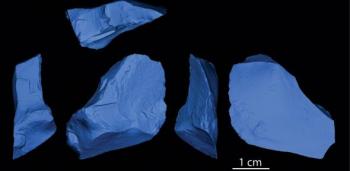The findings reveal that modern humans inhabited cool steppe-like conditions during that period. They also add to the evidence modern humans were in Europe at the same time as Neanderthals, and the overlap between the two is longer than previously thought.
The international team at the University of Cambridge in the UK, identified the stone tools as belonging to the Aurignacian culture, which is thought to indicate presence of modern humans.
They report their findings in the Proceedings of the National Academy of Sciences.
Modern humans and Neanderthals overlapped for much longer than previously thought
With the new findings at the Willendorf site, the investigators push back the date when early modern humans dispersed into Europe - which is thought to be around 40,000 years ago. Their study puts them in Europe at a potentially earlier period, when temperatures north of the Alps were cool.

Radiocarbon dating with stratigraphy show the stone tools - including small "bladelets" - date from 43,500 years ago.
The remarkably early date of the finds shows that modern humans and Neanderthals overlapped for much longer than we thought and that modern humans coped well with a variety of climates.
The discovery follows the recent publication of another study led by the University of Oxford that revealed Neanderthals and modern humans co-existed for thousands of years.
The team behind that study used improved radiocarbon dating techniques to analyze samples of bone, shell and charcoal from key archeological sites around Europe, ranging from Russia to Spain.
The tools that the investigators excavated between 2006 and 2011 include small "bladelets" that they believe were once part of tools that were thrown. Like the team in the Oxford study, they used radiocarbon dating with stratigraphy, to show the tools date to 43,500 years ago.
This date makes the objects significantly older than other Aurignacian artifacts, which have been found all over Europe. It puts modern humans in a region that is now Austria, at the same time as Neanderthals were living in other parts of Europe, suggesting they co-existed for longer than previously thought.
The research team says the find at Willendorf strongly suggests Neanderthals and modern humans met and interacted, and may well have exchanged both mates and ideas.
The picture emerging from this study is fascinating because we see significant changes in the material culture of the last Neanderthals - and these changes occur at the same time that modern humans were present at Willendorf. The timing of these events cannot be a coincidence.
Modern humans coped with variety of climates and environments
The team also analyzed the soil the tools were discovered in. This showed the people who used them were living in a climate that was cool and steppe-like, with river valleys full of conifer trees.
Previous studies have suggested modern humans spread through Europe during either a very cold period or during a warmer period, but these new results suggest the early modern human settlers, who are thought to have come to Central Europe from the warmer environments of southern Europe, did so in a cool steppe-type climate.
The findings indicate that rather than tracking a particular environment, early modern humans coped well with a range of different environments and were resilient to a variety of climatic conditions.
No comments:
Post a Comment